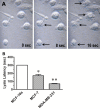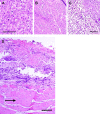Selective lysis of breast carcinomas by simultaneous stimulation of sodium channels and blockade of sodium pumps
- PMID: 29643996
- PMCID: PMC5884651
- DOI: 10.18632/oncotarget.24581
Selective lysis of breast carcinomas by simultaneous stimulation of sodium channels and blockade of sodium pumps
Abstract
Sodium influx through voltage-gated sodium channels (VGSCs) coupled with balanced removal of sodium ions via Na+, K+-ATPase is a major determinant of cellular homeostasis and intracellular ionic concentration. Interestingly, many metastatic carcinomas express high levels of these channels. We hypothesized that if excess VGSCs are activated and Na+, K+-ATPase is simultaneously blocked, the intracellular Na+ concentration should increase, resulting in water movement into the cell, causing swelling and lytic cell death. MDA-MB-231 breast cancer cells over-express VGSCs by 7-fold. To test our hypothesis, we treated these cells in vitro with the Na+, K+-ATPase blocker, ouabain, and then stimulated with a sublethal electric current. For in vivo histologic and survival studies, MDA-MB-231 xenografts were established in Nu/J mice. Mice injected with saline or ouabain were electrically stimulated with trains of 10 msec 10V DC pulses. Within seconds to minutes, the cells swelled and lysed. MCF-10a cells, which express normal VGSCs levels, were unaffected by this treatment. Cells from the weakly-malignant cell line, MCF-7, which express 3-fold greater VGSCs than MCF-10a cells, displayed an intermediate time-to-lysis. The rate of lysis correlated directly with the degree of sodium channel expression and malignancy. We also demonstrated efficacy in cell lines from prostate, colon and lung carcinomas. Treated MDA-MB-231 xenografts showed 60-80% cell death. In survival studies, TOL-treated mice showed significantly slower tumor growth vs. controls. These results are evidence that this "targeted osmotic lysis" represents a novel method for selectively killing cancer cells and warrants further investigation as a potential treatment for advanced and end-stage breast cancer.
Keywords: cancer; epithelial carcinoma; sodium channels; sodium pumps; targeted osmotic lysis.
Conflict of interest statement
CONFLICTS OF INTEREST The authors are co-founders and managing members of Oleander Medical Technologies, LLC.
Figures





References
-
- Nichols H. The top 10 leading causes of death in the US, Medical News Today. 2015. Available from URL: http://www.medicalnewstoday.com/articles/282929.php. Accessed 16 Dec 2016.
-
- Nguyen DX, Massagué J. Genetic determinants of cancer metastasis. Nat Rev Genet. 2007;8:341–352. - PubMed
-
- Fraser SP, Diss JKJ, Chioni AM, Mycielska ME, Pan H, Yamaci RF, Pani F, Siwy Z, Krasowska M, Grzywna Z, Brackenbury WJ, Theodorou D, Koyutürk M, et al. Voltage-gated sodium channel expression and potentiation of human breast cancer metastasis. Clin Cancer Res. 2005;11:5381–5389. - PubMed
LinkOut - more resources
Full Text Sources
Other Literature Sources
Research Materials
Miscellaneous

